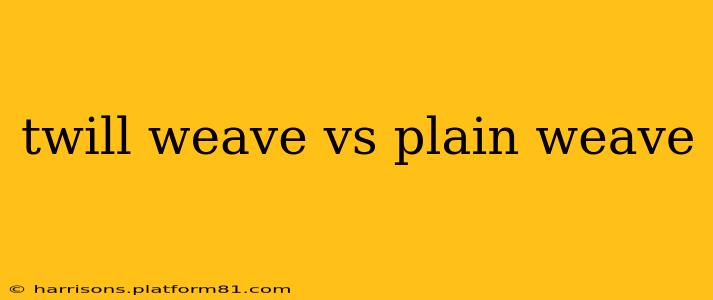Choosing the right fabric for your project depends heavily on understanding the underlying weave structure. Two of the most common weaves are plain weave and twill weave, each offering distinct characteristics in terms of texture, drape, and durability. This detailed comparison will explore the key differences between twill weave and plain weave fabrics, helping you make informed decisions for your sewing or textile projects.
What is Plain Weave?
Plain weave is the most basic and simplest type of fabric construction. It's characterized by a straightforward, one-over-one-under pattern of interlacing warp and weft yarns. This creates a balanced, even fabric with a relatively uniform appearance on both sides. Think of a checkerboard pattern—that's the essence of a plain weave.
Characteristics of Plain Weave:
- Simple Structure: Easy to manufacture, making it often a cost-effective choice.
- Even Texture: Produces a smooth, consistent surface.
- Moderate Durability: Generally durable, but can be prone to wrinkling and tearing depending on the yarn type.
- Breathability: Often breathable, making it suitable for clothing.
- Examples: Cotton broadcloth, muslin, calico, linen
What is Twill Weave?
Twill weave is a more complex weave structure than plain weave. It's created by passing the weft yarn over one or more warp yarns, then under one warp yarn, creating a diagonal line or rib on the fabric's surface. This diagonal pattern is the defining characteristic of twill weave. The number of warp yarns the weft yarn passes over before going under determines the steepness of the diagonal.
Characteristics of Twill Weave:
- Diagonal Pattern: This is the most distinctive feature, creating visual interest and texture.
- Durability: Generally more durable and wrinkle-resistant than plain weave, due to the tighter interlacing.
- Drape: Twill fabrics often have a good drape, making them suitable for garments and upholstery.
- Texture: Can have a slightly heavier and more substantial feel than plain weave.
- Examples: Denim, gabardine, serge, cavalry twill
Twill Weave vs. Plain Weave: A Head-to-Head Comparison
| Feature | Plain Weave | Twill Weave |
|---|---|---|
| Weave Structure | One-over-one-under | Diagonal interlacing (over one or more, under one) |
| Texture | Smooth, even | Diagonal ribs, slightly textured |
| Durability | Moderate | High |
| Drape | Varies depending on fiber | Good drape, often supple |
| Wrinkle Resistance | Low | High |
| Cost | Generally less expensive | Generally more expensive |
| Breathability | Generally good | Varies depending on fiber and weave density |
What are the differences between twill and plain weave fabrics?
The primary difference lies in the weaving pattern. Plain weave uses a simple over-under pattern, resulting in a flat, even surface. Twill weave uses a more complex pattern, creating a diagonal rib and a more textured surface. This difference in structure leads to variations in durability, drape, and overall feel.
What are some examples of fabrics with a plain weave and a twill weave?
Plain Weave Examples: Muslin, calico, broadcloth, poplin.
Twill Weave Examples: Denim, gabardine, chino, herringbone.
Which weave is better, plain weave or twill weave?
There's no single "better" weave; the ideal choice depends on the intended use. Plain weave is suitable for lightweight, breathable fabrics, while twill weave offers greater durability and wrinkle resistance. Consider the project's requirements (strength, drape, cost) when selecting between the two.
How can you tell the difference between a plain weave and a twill weave?
Examine the fabric closely. Plain weave will have a consistent, even texture with no visible diagonal lines. Twill weave will exhibit a distinct diagonal pattern or rib. You can also try feeling the fabric; twill weave often feels slightly more substantial.
This comparison highlights the key distinctions between plain and twill weaves. By understanding these differences, you can select the most appropriate fabric for your next project, ensuring the finished product meets your specific needs in terms of texture, durability, and aesthetic appeal.
